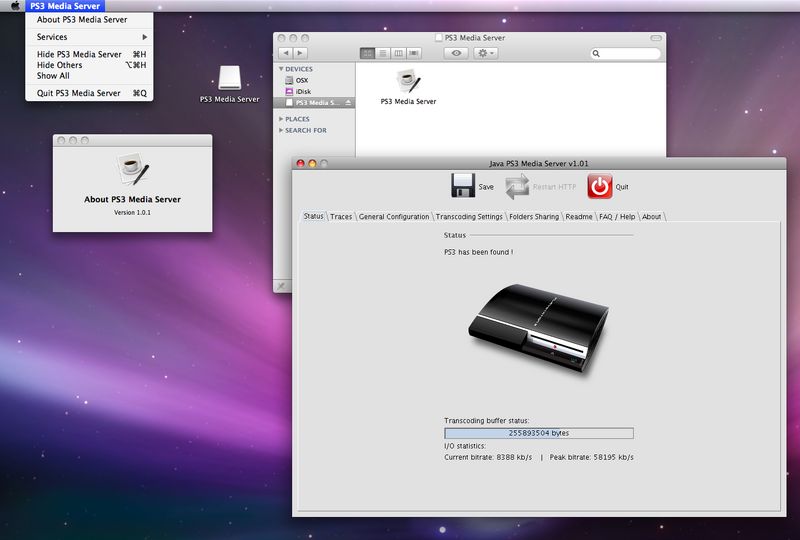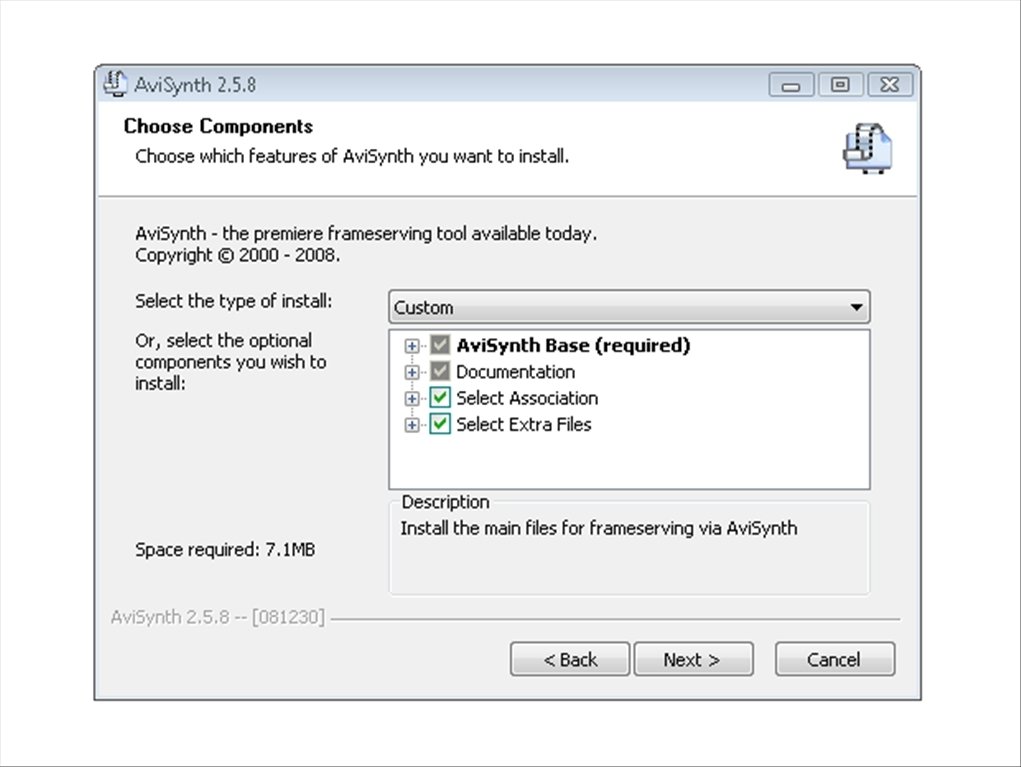
- Avisynth For Mac Windows 10
- Avisynth For Mac Download
- Avisynth For Mac 10
- Avisynth For Mac Windows 7
- Avisynth For Mac Torrent
- Avisynth For Mac Pro
AviSynth+ is a fork of the well-known frameserver featuring new functionality and optimizations not available in mainline. In the hope of modernizing AviSynth to meet present day needs and expectations, the project encourages everybody to help reach our goals: add long-sought features, energize the community, and improve developer and user friendliness. AviSynth is a powerful tool for video post-production. It provides ways of editing and processing videos. AviSynth works as a frameserver, providing instant editing without the need for temporary files. AviSynth itself does not provide a graphical user interface (GUI), but instead relies on a script system that allows advanced non-linear editing. Avisynth is not an application as much as it is a driver. Conventionally, avisynth files have a suffix of '.AVS'. Existing video for windows-aware applications can open.avs files and display the video. The strange thing is that.avs files don't contain any video! Instead, they are scripts that describe how to generate video.
More releases
If you find FFmpeg useful, you are welcome to contribute by donating. More downloading options
Get packages & executable files
FFmpeg only provides source code. Below are some links that provide it already compiled and ready to go.
Linux Packages
Linux Static Builds
Windows EXE Files
macOS
Get the Sources
Avisynth For Mac Windows 10
You can retrieve the source code through Git by using the command:
FFmpeg has always been a very experimental and developer-driven project. It is a key component in many multimedia projects and has new features added constantly. Development branch snapshots work really well 99% of the time so people are not afraid to use them.
Git Repositories
Since FFmpeg is developed with Git, multiple repositories from developers and groups of developers are available.
| Clone URL | Description |
|---|---|
| Main FFmpeg Git repository | |
| https://git.ffmpeg.org/ffmpeg-web | Main ffmpeg.org website repository |
| https://git.ffmpeg.org/fateserver | fate.ffmpeg.org server software repository |
| Mirrors | |
| Mirror of the main repository | |
| Mirror of the website repository | |
| Mirror of the FATE server repository | |
Releases
Approximately every 6 months the FFmpeg project makes a new major release. Between major releases point releases will appear that add important bug fixes but no new features. Note that these releases are intended for distributors and system integrators. Users that wish to compile from source themselves are strongly encouraged to consider using the development branch (see above), this is the only version on which FFmpeg developers actively work. The release branches only cherry pick selected changes from the development branch, which therefore receives much more and much faster bug fixes such as additional features and security patches.
FFmpeg 4.3.1 '4:3'
4.3.1 was released on 2020-07-11. It is the latest stable FFmpeg release from the 4.3 release branch, which was cut from master on 2020-06-08.
It includes the following library versions:
FFmpeg 4.2.4 'Ada'
4.2.4 was released on 2020-07-09. It is the latest stable FFmpeg release from the 4.2 release branch, which was cut from master on 2019-07-21.
It includes the following library versions:
FFmpeg 4.1.6 'al-Khwarizmi'
4.1.6 was released on 2020-07-05. It is the latest stable FFmpeg release from the 4.1 release branch, which was cut from master on 2018-11-02.
It includes the following library versions:
FFmpeg 4.0.6 'Wu'
4.0.6 was released on 2020-07-03. It is the latest stable FFmpeg release from the 4.0 release branch, which was cut from master on 2018-04-16.
It includes the following library versions:
FFmpeg 3.4.8 'Cantor'
3.4.8 was released on 2020-07-04. It is the latest stable FFmpeg release from the 3.4 release branch, which was cut from master on 2017-10-11.
It includes the following library versions:
FFmpeg 3.2.15 'Hypatia'
3.2.15 was released on 2020-07-02. It is the latest stable FFmpeg release from the 3.2 release branch, which was cut from master on 2016-10-26.
It includes the following library versions:
FFmpeg 2.8.17 'Feynman'
2.8.17 was released on 2020-07-07. It is the latest stable FFmpeg release from the 2.8 release branch, which was cut from master on 2015-09-05. Amongst lots of other changes, it includes all changes from ffmpeg-mt, libav master of 2015-08-28, libav 11 as of 2015-08-28.
It includes the following library versions:
Old Releases
Older versions are available at the Old Releases page.
So, it turns out I made a mistake. I assumed that QTGMC still didn't work properly in 64-bit AVISynth, even though it had been over a year since I looked into it.Not only does it work, it actually gives a 10%-20% speed boost during rendering.
BIG DISCLAIMER: This process may not work, may crash, or do other things to your system. Always check your files before submitting/uploading them.
Virus scan everything you download. It's not a 100% guarantee that you'll avoid getting a malware infection, but it's a lot better than not checking at all.
You have been warned.
Also, this tutorial is for Windows 10. Most of the steps work for previous versions of Windows, but may require slight modifications. Users of MacOS and other OSes should look elsewhere.
Here's the video version of the tutorial:
Avisynth For Mac Download
Also, I will be rushing through some of the initial steps for 32-bit AVISynth+, so if you'd like a little more depth, check out my original tutorial first, or check out my video version of that tutorial:
BIG DISCLAIMER: This process may not work, may crash, or do other things to your system. Virus scanning all files is strongly encouraged, but not a 100% guarantee of safety.
You have been warned.
If you're on a deadline (and using Premiere Pro, After Effects, or Final Cut Pro) probably your best best is to use a paid plugin like FieldsKit. And no, they aren't paying me to say that.
Also, this tutorial is for Windows 10. Most of the steps work for previous versions of Windows, but may require slight modifications. Users of MacOS and other OSes should look elsewhere.
Avisynth For Mac 10
First of all, AVISynth+ installs both the 32-bit and 64-bit versions by default. You can grab it from here:https://github.com/pinterf/AviSynthPlus/releases
Then, we'll need to get all the filters (plugins) needed:
FFMPEGSource
11/6/2018 Update: looks like Jiangmin antivirus is currently flagging FFMpegSource with a warning on VirusTotal. Given that no other antivirus engines have spotted anything, I'm cautiously calling this a false positive, especially because one of the top search results for Jiangmin on Google is a post about the problems with reporting false positives to them.
QTGMC
Don't forget to get all the 'Core Plugins', along with 32-bit FFTW3 library as well.
If you need to sharpen the image, I recommend LimitedSharpen (Technically 'LimitedSharpenFaster')
With all the AVISynth filters and scripts grabbed, it's time to get the supporting software:
Avisynth For Mac Windows 7
AvsPModThis is like an IDE for AVISynth scripts, and is pretty much essential IMO. Be sure to grab both the 32-bit and 64-bit versions.
FFMPEG
7-zip
If you don't have 7-zip already installed, you won't be able to open many of the downloaded archives. The version you get here doesn't matter, so maybe just do the 64-bit one.
After virus scanning everything, install:
7-zip (if needed)
AVISynth+

Avisynth For Mac Torrent
Just follow the default options in both cases. Then, go to the 32-bit plugins directory for AVISynth+. On my system, this is:C:Program Files(x86)AVISynth+plugins+
Extract all .dll and .avsi files to the plugins directory from all plugins EXCEPT the fftw-3*.dll archive. If there's a choice between an x86 and an x64 version, use the x86 version. If there's a choice between AVX, AVX2 and a version without either, you'll need to know what instruction sets your processor supports. CPU-Z can tell you this if you're not sure.

Once that's done, do the same with the 64-bit versions of the plugins, except copy those to the 'plugins64+' folder.
Now, open the fftw-3*.dll archive, then (as noted on the QTGMC page) extract the libfftw3f-3.dll file. Make a copy of it and rename it as 'FFTW3.dll'. Place the files 'libfftw3f-3.dll' and 'FFTW3.dll' in the SysWow64 folder.
Extract the 32-bit AvsPMod archive to wherever you want to run it from, and then extract the 64-bit version to a different directory. If you want to associate .avs files with AvsPMod, I would generally recommend doing so with the 32-bit version, but if you work primarily in 64-bit, then you should probably use that version.
Now, for the tricky part: setting up both the 32 and 64-bit versions of FFMPEG to run from any directory on your computer. We're going to do this with batch files. Also, kudos to Jon Hall's tutorial blog post on FFMPEG setup (currently defunct) for showing me basically how to do this.
First, open the 32-bit FFMPEG archive, then open the long-named folder within.
Create a folder somewhere on your system called 'ffmpeg32'. Personally, I put it in Program Files (x86).
Copy the 'bin' and other folders from the opened FFMPEG archive to your ffmpeg32 folder.
Create a new text file, then rename it to 'ffmpeg32.bat'.
Right-click on the batch file and select 'edit'.
Avisynth For Mac Pro
Write some version of the following into the notepad window:@ECHO OFFAdjust the path as needed depending on where you installed 32-bit FFMPEG. Save, close batch file. Keep the explorer window showing the contents of your ffmpeg32 folder open.
'C:Program Files (x86)ffmpeg32binffmpeg.exe' %*
Do the above steps for the 64-bit version of FFMPEG, except change the folder name to 'ffmpeg64' and the batch file name to 'ffmpeg64.bat'. In the batch file, put some version of the following:
@ECHO OFFAs you can see, I put ffmpeg64 in Program Files, but again, you can put it wherever you want.
'C:Program Filesffmpeg64binffmpeg.exe' %*
Save, and close the batch file. Keep the explorer window showing the contents of your ffmpeg64 folder open.
Now, to add both versions of FFMPEG to your system path:
- Press the Windows and R keys.
- Type 'control sysdm.cpl,3'.
- Click 'Run'.
- Click on 'Environment Variables'.
- Select 'Path' under 'System variables' and click 'Edit'.
- Go to where your ffmpeg32.bat file is.
- Select and copy the folder's path address from the address bar towards the top of the window.
- Back in the 'Edit environment variable' window, click 'New' and paste in the folder path.
- Repeat steps 6-8, but use the location of your ffmpeg64.bat file.
- Click OK on all the windows you opened to get here.
Now, whenever you make your .bat file to run ffmpeg, you can specify whether you want to run the 32-bit version of both FFMPEG and AVISynth by calling ffmpeg32, like so:
ffmpeg32 -i 'videofile.avs' -c:v prores -profile:v 3 -pix_fmt yuv422p10le 'output.mov'
If you want to run the 64-bit versions of FFMPEG and AVISynth, just call ffmpeg64 instead, like so:
ffmpeg64 -i 'videofile.avs' -c:v prores -profile:v 3 -pix_fmt yuv422p10le 'output.mov'
PS: FFMPEG doesn't generate 'official' ProRes files, so if it will be the last stop in your export chain, consider using a different workflow if the file is going to a major TV channel. Some channels have reportedly (on Reddit's /r/editors subreddit) said that FFMPEG ProRes files won't pass QC with them.